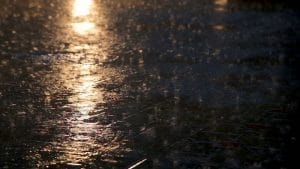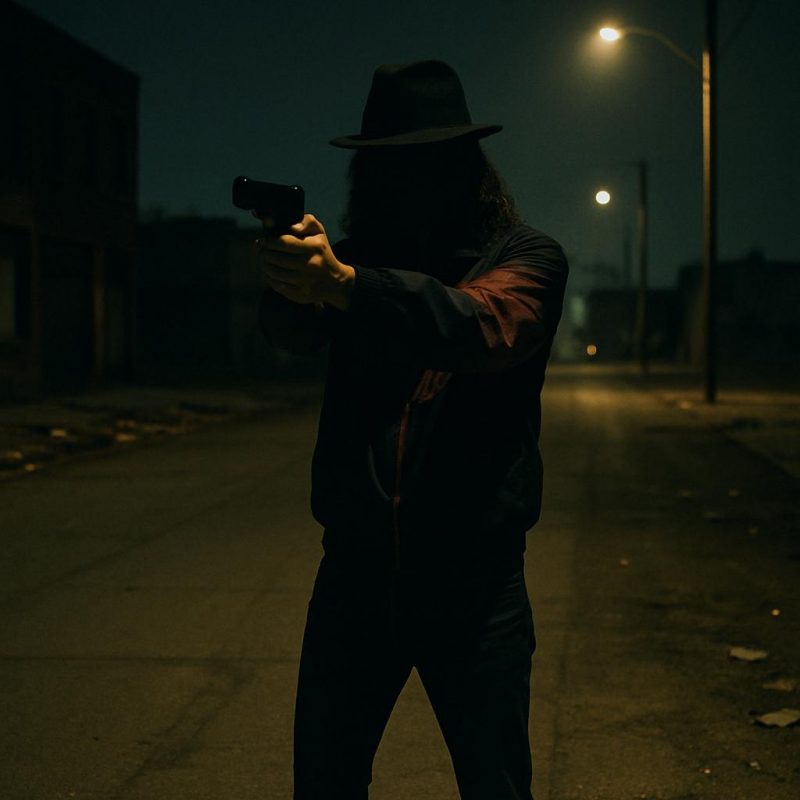Moonshot [Part 7] – The Abyss Stares Back
Cryptocurrency is Deek’s last chance to succeed in life, and he will not stop, no matter what.
Previous Chapters: Part 1 | Part 2 | Part 3 | Part 4 | Part 5 | Part 6
“He who sows winds, reaps storms.” – Spanish proverb
“If you stare into an abyss long enough, the abyss stares back at you.” – Friedrich Nietzsche
On AlertZaid Karim pulled into the motel parking lot and parked in a dark corner. Rania had said that Deek bought a black Porsche, and there it was, parked in front of room 9, looking like a black diamond in a hayfield among the twenty or so dented sedans, aging Japanese cars, and dirty trucks in this lot. The lights in room 9 were still on, but the curtains were firmly closed. A white van with tinted windows idled in the center of the lot, dirty exhaust pouring from its tailpipe into the chill night air. That was suspicious, and it put his senses on alert. He decided to remain in place and monitor the van before making any move.
Kidnap Manuel “Manny” Cesar wasn’t sure whether he believed in God or fate, but both were great when they put food on your plate. As it turned out, there was no need to lure the target, a man named Deek, out of the room, as the car thief exited room number 9 entirely on his own. Shujaa had given a description of the guy, and it matched exactly. He was built like Oscar, tall and overweight, but with a mass of curly hair and a short beard. He carried the car keys in one hand.
Manuel “Manny” Cesar wasn’t sure whether he believed in God or fate, but both were great when they put food on your plate. As it turned out, there was no need to lure the target, a man named Deek, out of the room, as the car thief exited room number 9 entirely on his own. Shujaa had given a description of the guy, and it matched exactly. He was built like Oscar, tall and overweight, but with a mass of curly hair and a short beard. He carried the car keys in one hand.
Manny gunned the van and pulled up next to the Porsche. Oscar leaped out and shot Deek with a high-voltage, military-grade taser. The big man crashed to the ground like a tree, and Manny and his vatos were on him like killer bees, dragging him by the knees, no time for wait or please. They hauled him into the van. The kid snatched the car keys, jumped in the Porsche, and peeled out. Manny was only a few seconds behind. The whole thing went down smoother than mantequilla on a hot tortilla.
They’d already laid out a tarp on the floor of the van to prevent bloodstains. As Manny drove, Oscar and Poison taped Deek’s hands, feet, and mouth, then proceeded to beat and kick him as they cursed, calling him a filthy Arab and a fat slob. The thief screamed in pain and terror, but the tape muffled his cries.
PursuitZaid had hardly shut the engine off and settled back in the seat to study the scene, when the door to room 9 opened, and Deek walked out. Zaid opened his car door to get out, but immediately the white van sped forward, men poured out and tased Deek, then threw him into the van, which sped away. Zaid leaped out of the car with his gun drawn, but the whole thing happened so fast. He didn’t think the kidnappers had even seen him. He jumped back into the car and started in pursuit.
The van drove southeast, skirting the edge of the warehouse district. Zaid followed from a distance, not wanting to be spotted. At night, this area was all shuttered warehouses, dark train yards, and empty streets. He was afraid they might take Deek into one of the warehouses. Depending on the level of security, it could make it hard to help him. A moving target was always easier.
When the van turned west on Altura Street, Zaid saw his chance. Altura was a rutted road with a railroad crossing that had a steep incline. You couldn’t speed down this road, it was impossible. There was nothing around but a railroad yard on the left, and a milk factory on the right. A half mile down, Altura exited onto Amsterdam Street, an extremely dark street that ran under the freeway. There was nothing at all on that stretch of Amsterdam, just empty lots filled with illegally dumped trash.
There was a shortcut to get around Altura, which Zaid only knew about because he’d taken a case involving the abandoned milk factory that rose now on the right. Someone had been sabotaging the factory, shutting down production two or three times a week. The lady who owned it hired Zaid to find out who was responsible. It turned out to be the owner’s husband, who was VP of production. He was having an affair with his secretary, and wanted to drive his wife to despair so she would sell the factory. He would then divorce her, take half the money in the settlement, and move to Brazil with the secretary. All very cliched, and perhaps obvious to an outsider, but the wife hadn’t seen it coming.
The husband went to prison, and the wife did indeed sell the factory, but so far, the new owners had done nothing with it. It had been sitting idle for a year.
The factory was gated, but the security road that encircled it was not. On the other side of the factory, there was a short, unpaved road that led to Amsterdam Street. It was a longer route than Altura, but the security road was well paved. He could circle around and enter Altura from the other side, cutting the van off.
Zaid turned onto the security road and hit the accelerator. The tires squealed as he took the curve like a stock car racer. He circled the factory in record time, shot down the dirt road, and bumped out onto Amsterdam, which was deserted. He sped on the wrong side of Amsterdam for a hundred meters, then turned onto Altura.
Sure enough, here came the van, still working its way slowly around the potholes, heading right toward him. Zaid parked his car behind a telephone pole, stepped out onto the road, and drew his gun.
Fourth DegreeManny cursed. It had been a stupid idea to turn onto Altura. He’d forgotten that it was under construction. He was just trying to get to that deserted stretch of Amsterdam, where they could dump this fat car thief amid the piles of old mattresses, broken washing machines, and rotting garbage.
They’d beaten the man badly. He lay on the tarpaulin, moaning, covered in blood. Served him right. Poison wanted to kill Deek, but Poison wanted to kill everyone. They hadn’t been hired to kill him. Just to send the message that if you messed with Mr. Z you got the fourth degree, and it wouldn’t be fun, son.
Manny was watching the road carefully, trying to steer around the potholes, and glanced up to see a man standing not twenty feet in front of the van, pointing a gun directly at him. The man was lean and muscular-looking, with black hair to his shoulders and a nasty scar on the upper part of his face. He wore jeans, black boots, a red and blue windbreaker, and a fedora, of all things.
“What the -”
Targets In the DarkZaid opened his eyes wide and narrowed his focus. The front seat of the van held a driver and a passenger. Behind them, there appeared to be a partition. Zaid sighted, and shot the driver through the windshield, then shot him again. The van careened off the road, narrowly missing him. As it passed, he fired quickly, barely aiming, not expecting to hit his target. Yet he did. He saw the passenger’s head jerk violently to the side as a bullet smashed through his skull. The van crashed into the security fence around the milk factory, then stalled, coming to a stop. Zaid dashed toward it.
Who Would Have Guessed?Manny heard a flat, sharp sound. A small, neat hole appeared in the windshield, surrounded by emanating cracks. He felt like he’d been punched in the chest. He looked down and saw blood seeping through his shirt. The man had shot him in the chest, who would have guessed?
His first thought was that he’d known this would happen one day. He’d hurt a lot of people in his lifetime. His grandmother, Abuela Anita, used to say, “Quien siembra vientos, recoge tempestades.” He who sows winds, reaps storms. The evil you put into the world always came back to you. He’d convinced himself that he wasn’t an evil man, but his heart knew better. If only he’d listened to it.
 This reminded him of Sunday mornings at Abuela’s table, when she made chilaquiles, tamales, huevos rancheros, atole, pan dulce, and coffee. All his surviving family – those who weren’t in prison or the grave – would gather around to feast, talk and laugh. He hadn’t been to Sunday breakfast lately, why was that? He’d been slippin’ and trippin’, and now he was done.
This reminded him of Sunday mornings at Abuela’s table, when she made chilaquiles, tamales, huevos rancheros, atole, pan dulce, and coffee. All his surviving family – those who weren’t in prison or the grave – would gather around to feast, talk and laugh. He hadn’t been to Sunday breakfast lately, why was that? He’d been slippin’ and trippin’, and now he was done.
The next bullet entered his chest from the side, clipping the edge of the left atrium of the heart that Manny had refused to listen to. He had a sudden vision of his Tio Ramirez, who’d spent half a lifetime incarcerated at San Quentin before committing suicide. Manny had visited Ramirez a few months before he killed himself. Ramirez’s eyes were hollow and tired that day, full of pain and regret. Speaking on a phone from the other side of a glass partition, Ramirez quoted some philosopher named Nietsche: “If you stare into an abyss long enough, the abyss stares back at you.”
As he died, Manny stared into the abyss, and the abyss stared back with wet black eyes that neither rhymed nor reasoned, but bored remorselessly into his soul.
A Universe of PainDeek drifted in a universe made entirely of pain. He didn’t know who these men were, but the two tattooed Mexicans who were with him in the rear of the van had been insulting and cursing him as they beat him, calling him car thief and other things. “Never mess with Mr. Z,” one of them said. Deek had no idea who that was. He would have told them that he was no car thief, that he paid for the car fair and square, but his mouth was taped shut.
His nose and mouth were full of blood, and he swallowed a mouthful of it so he wouldn’t choke. His jaw felt crooked, and the sides of his torso felt liquid and broken. Blood ran into one eye, stinging and blinding him, and he blinked rapidly, trying to clear it.
Patience is at the first blow, Imam Saleh had said. This thought ran through Deek’s head like a mantra as he mumbled, “Inna lillahi wa inna ilayhi raji’oon,” again and again.
The two men had quit beating him at least, and now sat on the side seat against the wall of the van.
He heard a sharp sound like a firecracker, then another, and he was thrown against the partition that separated the front seats from the rear cargo area. The two kidnappers were thrown to the floor as well, one of them landing atop Deek. The man they called Poison rose with a curse, drew a large handgun from his waistband and opened the rear door of the van. An instant later a gunshot rang out and Poison tumbled back into the van with a bullet hole in his forehead.
The man who’d been thrown atop Deek – Oscar – shouted, “Chingada!” and scrambled to his feet. Yanking Deek to a sitting position, Oscar kneeled behind him and put a knife to his throat.
ShowdownA moment later a man wearing a brown fedora stepped into the van, gun in hand. Even with all his pain, Deek grinned, making the tape pull against the corners of his mouth. Tears sprung to his eyes as he wept with relief. It was Zaid Karim Al-Husayni. The man, the hero, the legend.
Because of his indirect familial relationship to the Palestinian-American private investigator, Deek knew more than most people about the dangers Zaid had faced and overcome. The man was a juggernaut, a one-man avalanche. As a youth he’d robbed banks all up and down California, spent six years in a maximum security federal penitentiary, been pardoned by the president of the USA after he saved a woman’s life in a prison riot, had survived innumerable assaults in the course of his job, and had killed a Panamanian drug kingpin in hand-to-hand combat. All that and more.
Deek didn’t know how Zaid had known of his predicament, or how he’d found him, but thank God. Alhamdulillah, alhamdulillah. Patience was at the first blow! If you showed sabr, Allah would make a way.
 Death was written in Zaid’s eyes as plain as a newspaper headline, and Oscar must have seen it, because panic infused the kidnapper’s voice as he shouted, “Stop! Drop your gun or I’ll cut this pendejo’s throat!”
Death was written in Zaid’s eyes as plain as a newspaper headline, and Oscar must have seen it, because panic infused the kidnapper’s voice as he shouted, “Stop! Drop your gun or I’ll cut this pendejo’s throat!”
Far from dropping the gun, Zaid raised it and sighted on the kidnapper’s head. “You kill him,” he said grimly, “and it will be the last thing you ever do in this world.”
“We work for Bandar Tzan’ani! You can’t mess with him.”
Deek saw the flash of recognition in Zaid’s eyes. But the legendary P.I. was as focused as a laser beam. He breathed slowly and deeply. His knees were slightly bent, his shoulders relaxed. He looked like a lion about to pounce.
“We can make a deal!” Oscar shouted as he kneeled behind Deek, hiding his face behind Deek’s head. “I let him go, you let me go.”
“I’ll make a different deal,” Zaid replied calmly. “What do you say, Deek?” He winked at Deek, and Deek thought he understood.
Deek winked back. An instant later he flung his head backward, smashing the back of his skull into the kidnapper’s nose. Oscar dropped the knife as his hands flew out in shock. Deek pitched himself sideways. Two shots rang out as Zaid put one bullet in Oscar’s face, and another in his chest.
“I shoot you and you die,” Zaid said, holstering his gun. “That’s the deal.”
Death Is Good EnoughZaid cut Deek’s bonds and removed the tape from his mouth.
“The man of the hour!” Deek shouted, or tried to. The pain in his jaw was terrible, and he winced as he gripped it.
“Are there any more of them?” Zaid asked seriously. “Another car?”
Deek climbed slowly to his feet. Even with all his injuries, and with the coppery taste of blood still coating his mouth, he felt exhilarated. He and Zaid had shown these guys what was what! What a rush! “No,” he mumbled, for his jaw would not work properly. “Just this piece of garbage.” He punctuated the last word with a kick to the dead kidnapper’s face, but the movement caused a massive wave of pain in his side, and he groaned.
“Come on,” Zaid said, taking him by the arm. “Death is good enough. They are facing worse trials now than what we can give them.”
Oscar had confiscated Deek’s phone when they kidnapped him. He needed that back, as it held his crypto wallets and the protected file with the secret keys. He shook off Zaid’s arm, went through the dead man’s pockets and found the phone.
The NamerDeek didn’t realize that Oscar had cut him until Zaid pressed a cloth against the side of his neck and said, “Keep pressure on this.” The hard-bitten detective put an arm around Deek and helped him to Zaid’s car. The pain of Deek’s wounds, especially his jaw and hand, filled his eyes with tears, and he watched blearily as Zaid shut the van’s doors, opened the gas cap, stuffed a rag into the fuel neck, and lit it. Zaid then hurried to the car, and they took off.
In the movies people always set something to blow then depart coolly, not looking back. But Deek was not that cool. He turned his head just in time to see the van jump into the air as it exploded in a fireball.
“I need to go to the hospital,” he tried to say, but the words sounded more like a moan than anything intelligible. The wave of energy he’d felt when Zaid had freed him was receding, leaving behind a glittering shoreline of pain.
“Don’t try to talk. I think your jaw is dislocated. I could try to reset it but I’m not experienced at that, so I’ll leave it to the Namer. Your nose is definitely broken as well.”
“Hospital,” Deek moaned.
“Can’t take you to the hospital. I just killed three men. In defense of my life and yours, but you never know how the cops will see it. Trust me, the Namer will take good care of you.”
Deek didn’t understand what Zaid was saying. The what? The Namer? He sat back in the seat, still pressing the cloth to his neck, and closed his eyes. Rain was falling again, and the rhythmic snick-snick of the wipers snagged at Deek’s mind and eased him into another state of consciousness. The pain of his wounds blissfully receded.
Human After All He found himself remembering a night from when he was twelve years old. He was in the car with his parents and Lubna, returning from eating at the Old Spaghetti Factory. It was raining, and the wipers were on, and Baba began to sing a traditional Iraqi song called Hayatna, matching it to the rhythm of the wipers.
He found himself remembering a night from when he was twelve years old. He was in the car with his parents and Lubna, returning from eating at the Old Spaghetti Factory. It was raining, and the wipers were on, and Baba began to sing a traditional Iraqi song called Hayatna, matching it to the rhythm of the wipers.
Mama joined in, and Lubna as well, but Deek refused to sing. He was too cool for that, and he cared more about American rock music than old Iraqi ballads. He mocked Lubna, telling her she sang like a crow.
Why had he been such a horrible punk? No wonder she hated him. He’d been nothing but a bully to her growing up.
What if he bled to death right here in this car seat? He would never get a chance to tell Lubna how sorry he was, and that she was actually a great singer, and that he had only been jealous at how much closer to their parents she was back then.
He snapped out of the reverie. The full intensity of his wounds hit him like another booted kick. He felt in his pockets for his phone, and took it out. The screen was cracked, but alhamdulillah it still worked.
He called Lubna. As it began to ring, Zaid snatched the phone away.
“I told you not to talk. Calling your family right now is not a good idea. You’ll scare them. You’re not dying. The cut on your neck is superficial. If it had been a little deeper you’d be dead now, but you were fortunate, alhamdulillah. We’ll get you patched up, I promise.”
Deek nodded and sank into the seat. Glancing at Zaid, he noticed that the detective’s arms were trembling on the steering wheel, and the man’s face was as pale as a high moon. What was wrong with him? As his mind slipped into darkness, it dawned on Deek that maybe the rescue had not been as easy for Zaid as it had seemed. Maybe he’d been frightened, or maybe the act of killing had shaken him up. Maybe Zaid, in spite of all the legends and stories about him, was human after all.
***
[Part 8 will be published next week inshaAllah]
Reader comments and constructive criticism are important to me, so please comment!
See the Story Index for Wael Abdelgawad’s other stories on this website.
Wael Abdelgawad’s novels – including Pieces of a Dream, The Repeaters and Zaid Karim Private Investigator – are available in ebook and print form on his author page at Amazon.com.
Related:
The post Moonshot [Part 7] – The Abyss Stares Back appeared first on MuslimMatters.org.


 The Madleen, en route to Gaza
The Madleen, en route to Gaza